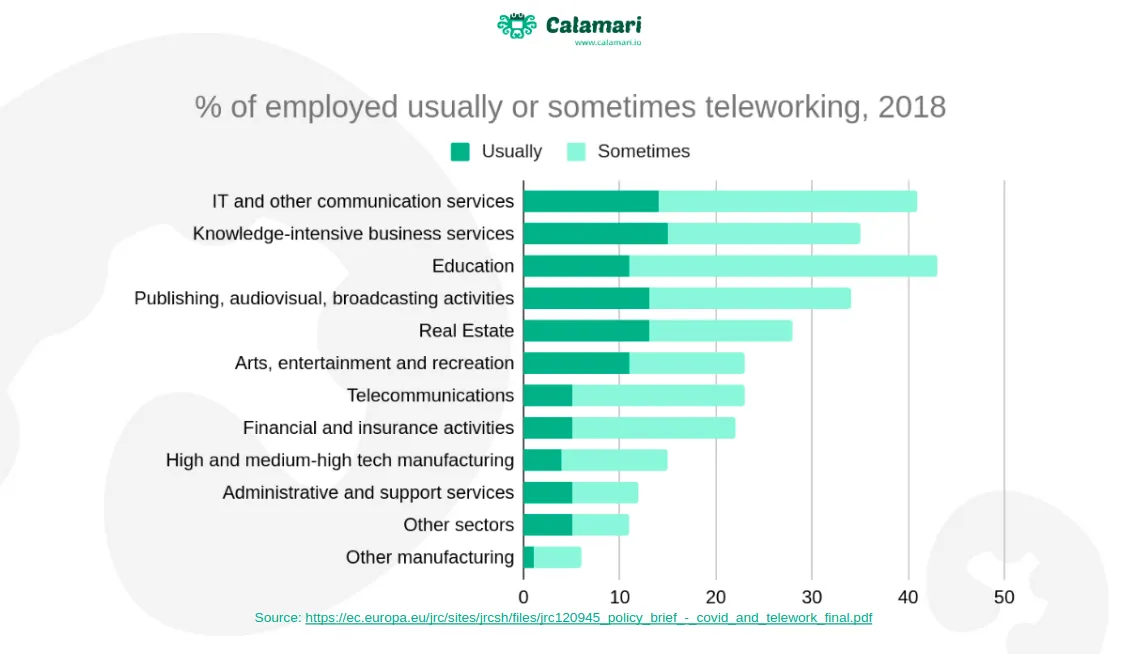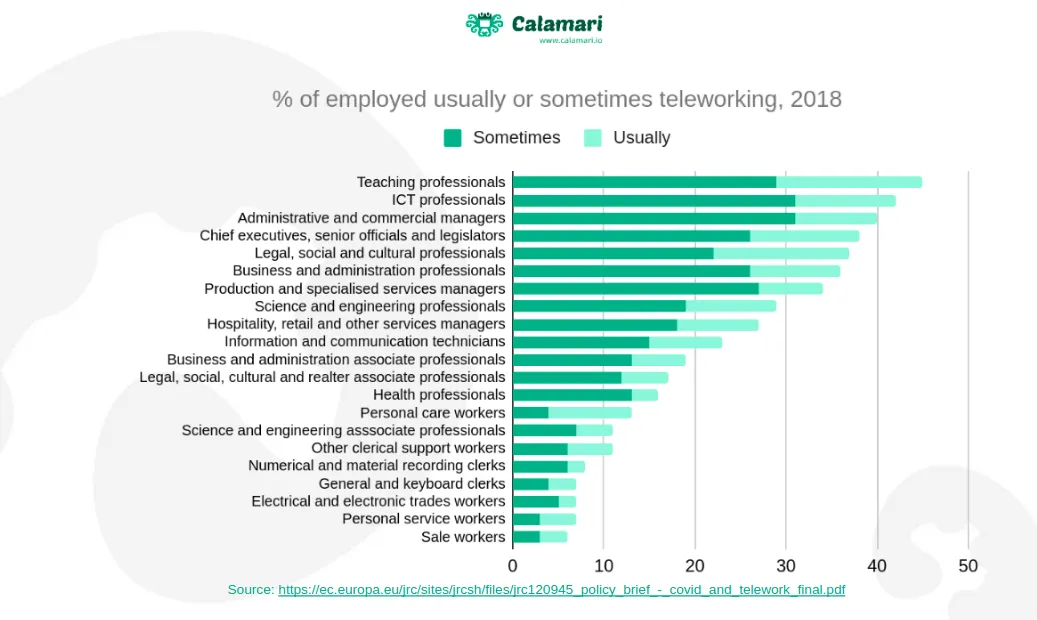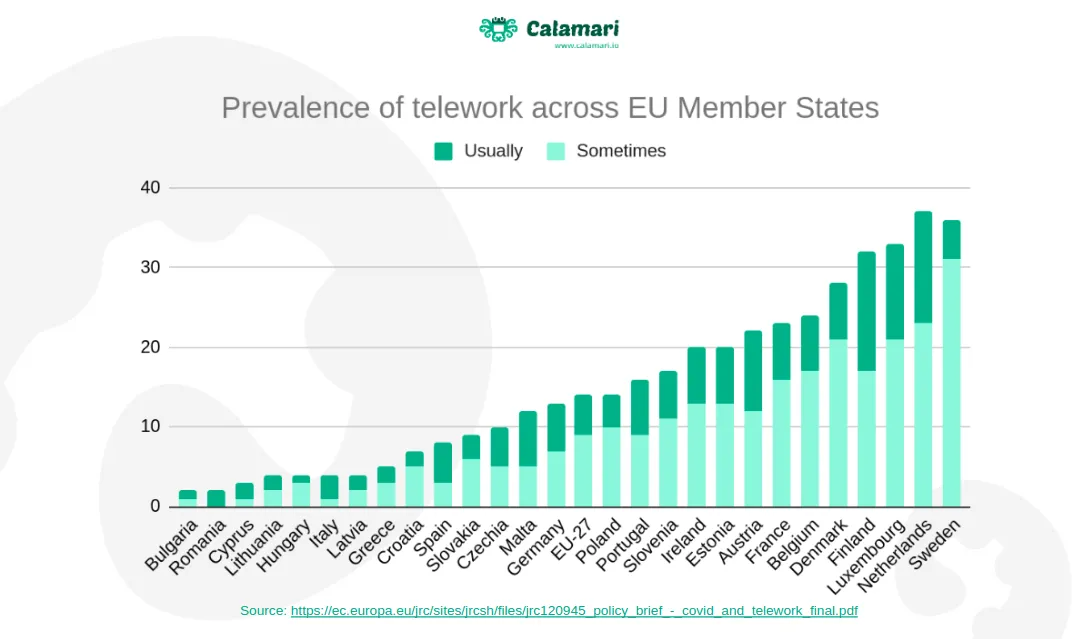Remote work in Europe before Covid-19 pandemic


The pandemic of COVID-19 triggered a fundamental shift in the approach toward teleworking or remote work. During the lockdown four of ten employees in the EU were working from home - a thing unimaginable a quarter before.
The early estimates done by the Eurofund suggest that up to 40% of all EU-based workforce switched into the remote mode. Before the pandemic, only about 15% of all workforce had ever worked remotely.
Switching to the telework was the only reasonable response to the threat posed by the spread of the new virus. What’s even more challenging, the germ is not yet researched enough to be certain about its impact on the population in the long term.
On the other hand though, it was a change unwitnessed before, impacting whole countries. But one would be terribly wrong if thinking that there was no remote working before COVID and there was no way to be prepared for this sudden shift.
Remote work in EU before Covid
The brief published by the European Commission indicates that the remote work is nothing new in the EU countries. There were various rates of adoption of course with significant differences between countries as well as industries or sectors.
Key takeaways from the report:
- Teh EU countries witness significant differences in the telework popularity and the COVID-19 pandemic only highlighted this trend.
- The popularity of remote work is highest among the knowledge-based and ICT specialists, especially higher-level ones.
- Approximately half of the workers who started the remote work during the COVID pandemic had no experience in this kind of work
- The ability to scale the telework can in fact result in widening the inequalities between economies, companies, or particular workers.
The data mentioned in the brief indicate that only 5.4% of EU-based workers were regularly working from home. The rest of the population, despite the constant yet slow rise of popularity of this pattern of work, has seen this way occasionally at best.
The self-employed, be that freelancers or highly skilled specialists working as consultants, were among the most frequently working from home with 36% of them claiming to work from home on a regular basis. The popularity of this type of work was lower among employees with a lesser amount of independence. The popularity of telework among dependent employes in the EU was slightly above 11%. Worth to mention, among these “freelancers” there are employees working from home regardless of the situation, like farmers or artisans.

Remote work popular in the ICT sector
The model of remote work was widely seen and used in the IT sector, where more than 40% of employees were working from home on a regular basis. The telecommunication sector was among leaders in the telework popularity, yet this approach was only half as popular as in the IT services (20%).
Also, highly skilled specialists like lawyers or consultants enjoyed high access to remote work with 30% of employees working this way before COVID-19 pandemic.
The telework was not popular in the administration and support services. Obviously, there was little to no telework in companies and industries that require physical contact or manipulation. There is no such thing as a “remote-working waiter”. The same challenge was seen in every position that requires face to face contact - beauticians, hair-dressers, or sales representatives.
The case of employee autonomy
Another factor that has influenced the popularity of telework was the level of autonomy of a particular employee with juniors having worse access to the remote work than seniors and management, despite having similar tasks or tools of the trade.
There was also a strong paradigm of administrative employees working only from the office despite the heavy-usage of ICT tools and the digital form of nearly all documents that are shared. Only about 10% of clerks and supporting office workers had any experience in working from home.

The limited access to the telework among junior workers and administrative staff was caused not only by the “prestige” factor with working remotely being seen as an employee benefit. Another factor was the trust in the employee and his or her level of autonomy. A junior programmer is more likely to make a mistake or need guidance from senior colleagues than the experienced specialist.
When it comes to office workers, the issue is in the delegation of power, where most of the employees needing to consult many decisions with their manager or higher staff. The access to the remote work is higher among the high-earners, so the trend itself is only deepening the inequalities.
Or at least - it used to do so before COVID. The pandemic has clearly shown, that there was none but a mental barrier to work remotely for many occupations.
Remote work before COVID in EU countries
Interestingly, the approach toward the telework and the income-related inequalities find their reflections in the country-specific differences. Putting it simply - the remote work is more popular in high-income countries. Also, the countries with a high level of mutual trust between people benefit from the high popularity of remote work.
This work paradigm was the most popular in Sweden, followed by the Netherlands, Luxemburg, and Finland. The leas popular it was in Bulgaria, Romania, and Cyprus.

The digital skills of the workforce
Last but not least, there was an impact of digital skills on remote work popularity. Obviously, the population with the highest digital skills was the most likely to work using advanced technologies.
As the 2019 data mentioned in the report indicates, the share of employees working on non-manual occupations with little to no digital skills varies from 10% in the Netherlands to 40% in Bulgaria. The need to develop digital skills in the workforce. Up to 42% of all the EU population has no digital skills at all.
For these people, the COVID-induced shift toward remote work and digital tools was shock therapy.
Summary - the new normal
For better or worse, the remote work is here to stay for longer. Companies were forced to put their workforce out of offices. Also, thousands of people just experienced all pros and cons of working from home.
Telework comes also with multiple other benefits with reducing traffic and air pollution among the most prominent. COVID pandemic has reduced the emissions by 26% per country on average during the peak of restrictions.
Also, the sudden popularization of the remote work made the lockdown possible. Without new technologies, be that broadband, portable devices, online cloud-based tools, and clock in and out software, the isolation would not be possible.
If you wish to talk about how to use modern time tracking software to enhance your remote or not-that-remote teams, just drop us a call. Also, if you just wish to share your remarks about the shift toward the remote work, don’t hesitate to contact us!

Read more our texts about Remote work, outsourcing and offshoring
- Remote work in Europe before Covid-19 pandemic
- Transparency at work – the foundation of an effective home office
- Working from home with kids – 8 rules to follow
- 5 reasons you should consider hiring a remote team
- Hiring remote employees? Here’s a list of must-have online tools for remote management.
- Offshore, nearshore, onshore – differences, and tips
- 5 tips on maximizing the offshore development team productivity
- 7 cool tips on how to manage an offshore team


















